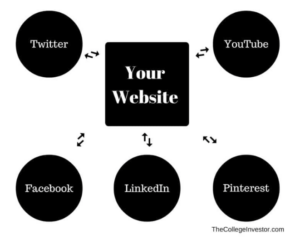Regardless of what kind of career you are pursuing, setting up an online presence is essential to not only show people yourself, but also to propel your job hunt before and after graduation. An online portfolio is a website dedicated to you and your accomplishments. As it gets harder and harder to find jobs while in or out of college, it is important to show employers you are more than a résumé.
While LinkedIn is an extremely effective resource in finding a job, your online portfolio will likely be the first to pop up when someone searches your name on Google. This is the best way to build your brand. No matter what major you are, an online portfolio is helpful.
Find a Website to Host your Portfolio
There are several starting places for your online portfolio, such as Squarespace, Wix, WordPress and Adobe. The Adobe Creative Cloud is free for all Penn State students. Squarespace is $12 per month, and Wix and WordPress have limited free options, but you have to pay to gain full access of the website.
Set It Up
Once you pick a website, most will give you the option to pick a theme or start from scratch. It is often easier to simply pick a theme or template for your website where you can fill in your own information and then pick and choose backgrounds and colors to make it more fitting to you and your style.
Showcase Yourself
This is your portfolio, so it makes sense that you are the center. Your ‘About’ page should quickly and neatly sum up your background — this includes your education and experience as well as any skills, awards or interests. It should summarize what is on your résumé and then you can also provide a link or attachment of your résumé for any viewer to download.
Find Your Best Work
It is important that you are proud of the work on your portfolio. Remember, visitors are going to be impressed with high quality work. It is always better to have a portfolio with a few stunning pieces than several that are just mediocre. Each piece should also have a title or small description. These should be short enough that the reader can simply glance and find what they are looking for.
Be Social
Once you create your online portfolio, you need to maximize the impact by connecting with as many people as possible. This means you need to include a contact form on your portfolio, which includes your primary email and your phone number. You should include links to share your work on social media. Another note is to keep your social media clean. You should be able to use it as a tool for attracting employers because they will most likely look at your various social media pages.

Photo from thecollegeinvestor.com
Keep It Current
As you continue to work and create more content, you’ll want to keep your website updated regularly. The best portfolios offer viewers something new and fresh every time they come back. In addition, your newest work should always be the first thing someone sees when they open your portfolio.
Have you ever considered starting a blog? While an online portfolio is more about you, your blog is more like an online journal to show what you know and do well. When updated frequently, a blog post with relevant information from your industry can show recruiters you are dedicated and creative. Add a link to your blog on your brand new online portfolio to keep everyone updated with your life on a more personal level.
An online portfolio is not just a trend, it will likely become expected by job recruiters everywhere in the future. It is a useful tool to propel you forward, so get ahead of the curve and get creative.





